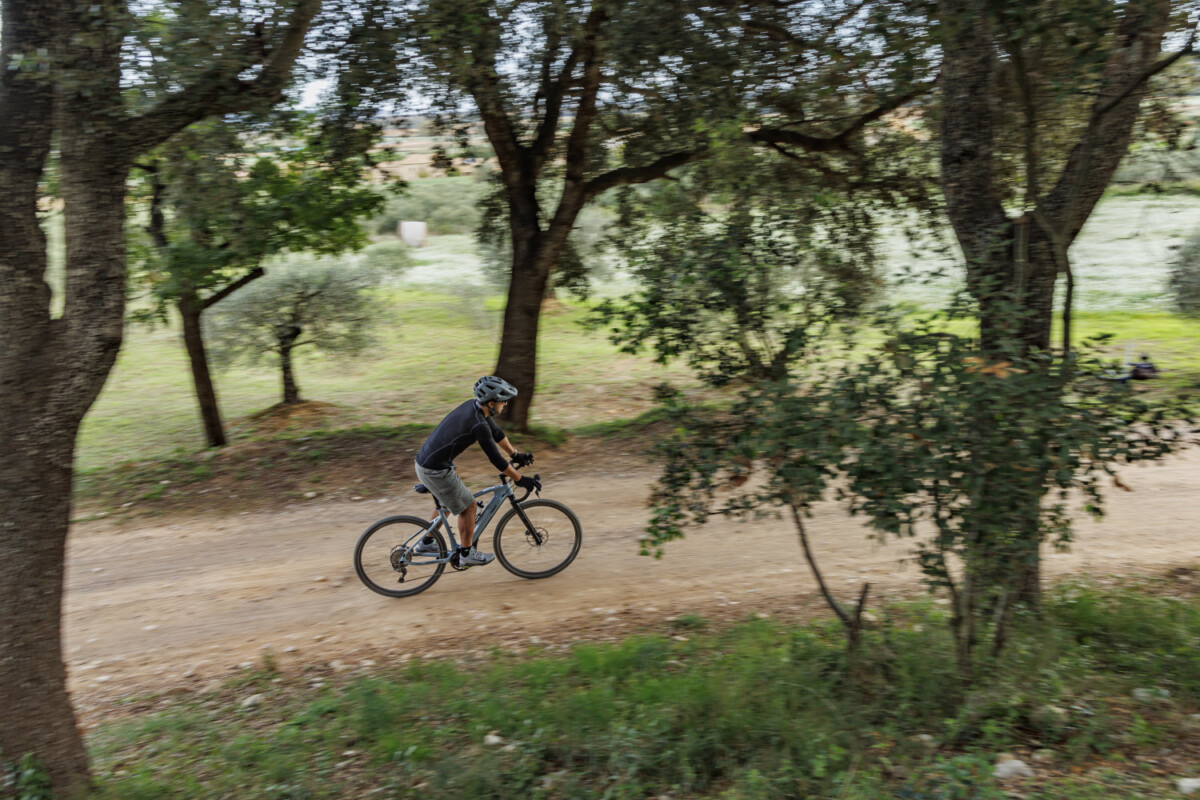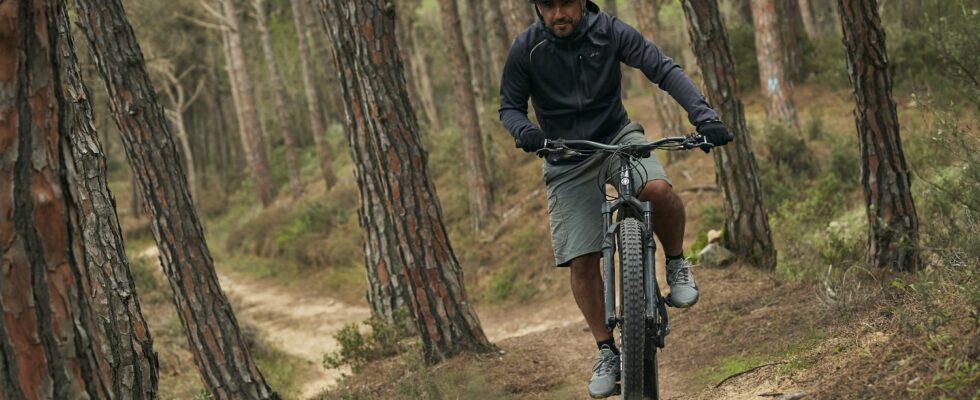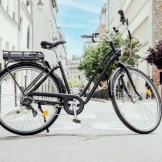After motorcycles and scooters, Yamaha intends to make a name for itself in the European market for electrically assisted bicycles. Three models will be launched in 2023 with the Yamaha CrossCore RC, Yamaha Wabash RT and Yamaha Moro 07 which will cover the urban VAE, Gravel and VTTAE segments. Here’s our take.
It is in the north of Spain that Yamaha presented its electrically assisted bicycles (VAE). A segment on which we did not necessarily expect the Japanese brand which is slow to announce its future motorcycles – the brand has already communicated on several electric scooters, such as the Yamaha Neo and the Yamaha E01.
However, the world of VAE is nothing new for Yamaha, which launched its first prototype in 1989, before marketing a first model called eBike four years later. You’ve never heard of it ?
This is not surprising despite a million units sold in 2008, the Japanese manufacturer focusing exclusively on its local market. It will take another ten years for Yamaha’s VAEs to cross the Pacific Ocean with the launch of marketing in the United States.
Yamaha CrossCore RC and Wabash RT, classic but efficient VAEs
While they will arrive in our regions next spring, we have already been able to take control of the last three Yamaha VAEs. Alongside the VTTAE Moro 07 on which we will come back later, the CrossCore RC and the Wabash RT are based on the same architecture. The first is a rather classic urban model, while the second takes the form of a gravel, located halfway between a road bike and an all-terrain bike.
Both are powered by a Yamaha PW-ST motor, which is integrated into the crankset – however, this is not Yamaha’s latest generation motor, the PWseries S2, presented in September 2022. It develops a nominal power of 250 W , with a torque of 70 Nm and pedal assistance up to 25 km/h.
The electric motor is paired with a 500Wh Li-ion rechargeable battery which is integrated into the downtube of the frame. Charging can be done directly on the bike, or by removing the battery after unlocking the lock with a key.

To control the electric assistance, the Yamaha CrossCore RC and Wabash RT incorporate a Display A control unit. At first glance, its shiny plastic finish and rudimentary appearance are surprising on bikes that are billed around euros and more. But in practice, they fulfill their mission perfectly, especially since the small LCD screen is perfectly readable even with the sun behind it.
It displays the level of assistance that can be selected using a dedicated button, the battery level, the instantaneous speed, the distance travelled, the total distance and the remaining autonomy in kilometres.
In this regard, Yamaha does not communicate any figures on the autonomy of its bikes which will depend on various parameters such as the level of assistance, the relief or the weight of the cyclist. We can nevertheless count on about 50 km.
Riding the Yamaha CrossCore RC and Wabash RT
Beyond the few common characteristics, the Yamaha CrossCore RC and Wabash RT stand out with equipment that is adapted to the segment for which they are intended.
The CrossCore RC is an urban model with a closed aluminum frame and an SR Suntour Nex-25C suspension front fork with 63mm of travel. Available in three sizes S, M and L, it features CST C1996 27.5×2 tyres, Shimano BR-MT200 hydraulic disc brakes, a Shimano CS-HG200-9 nine-speed cassette and an RD-M3100-SGS derailleur for example.
For its part, the Yamaha Wabash RT is a gravel bike that benefits from a telescopic seat post suspended up to 60 mm (40 mm for the size S frame), Maxxis Rambler 700 x 45C tires, Shimano BR brakes -RX400, without forgetting the Shimano CS-M7000-11 cassette and the Shimano RD-RX812 11-speed derailleur.
In both cases, the manufacturing quality is there with a neat finish. The cables are for example integrated into the frame, but some details leave something to be desired on the Yamaha CrossCore RC. Besides the absence of accessories such as mudguards or a luggage rack, its lighting system seems to have been added in a hurry.

Source: Driss Abdi

Source: Driss Abdi

Source: Driss Abdi

Source: Yamaha

Source: Yamaha
Thus, the front and rear LEDs must be turned on and off manually, and they are not powered by the bicycle battery. It will therefore be necessary to think of recharging them via their USB port. However, the Display A console has a dedicated button for lighting if the user were to replace the standard LED system.
Unsurprisingly, the Yamaha CrossCore RC stands out for its balance and comfort compared to a much firmer Wabash RT, and therefore necessarily less suitable for everyday use, at least for the general public. On the road, the latter allows you to reach (and maintain) quite easily a cruising speed of 35 km/h, when the CrossCore RC requires more effort once you have exceeded 25 km/h. electric assistance.
On the other hand, in the absence of suspensions and with 700 x 45C tires, the Wabash RT brings up all the vibrations in the arms and at the level of the cervical which take for their grade. Admittedly, the terrain was more suitable for an ATV, but either way, it’s best to stick to the road and dirt roads riding the Wabash RT.
Both bikes offer impeccable stability, which is reassuring when you reach very high speeds downhill (nearly 80 km/h) as was the case when we got started near Begur, in a mountainous region of the northern Spain. The engine in the low position lowers the center of gravity, which is felt in the maneuverability.

Source: Yamaha

Source: Yamaha

Source: Yamaha
The latter is silent while delivering a comfortable torque of 70 Nm. Chaining the kilometers at an average speed of 20 km / h is no problem, despite the elevation gain of nearly 500 meters encountered during our grip. .
In addition to the traditional +Eco, Eco, Standard and High modes, the Yamaha CrossCore RC and Wabash RT have a rather effective Auto mode. This adapts the power according to the motor skills as can the traction control, as well as the ground by relying on a tilt sensor. The cyclist can therefore content himself with pedaling by choosing the most suitable speed.
Finally, the two bikes can also rely on a very efficient and really reassuring braking system when you pick up speed. The controls fall well under the fingers and the hydraulic disc brakes combined with four-piston calipers offer excellent bite.
Yamaha Moro 07, an efficient VTTAE
The Yamaha Moro 07 will be the top of the range model released by Yamaha in Europe next spring. This is in fact the 7th version of the e-MTB from the Japanese manufacturer, which has gone straight to digging into its technologies from the motorcycle to design the Dual Twin Frame, which again offers excellent stability to the bike. Comprised of two upper tubes and two down tubes, the frame was developed at the same time as the PW-X3 engine that powers the Yamaha Moro 07.
According to Yamaha, this is its smallest motor, but also the most powerful in its range of e-bikes with 250 W of nominal power and a torque of 85 Nm. The power supply is provided by a rechargeable Yamaha Lithium battery Ion of 500 Wh which should give it a range of about 100 km.

Source: Driss Abdi

Source: Driss Abdi

Source: Driss Abdi
The power is there, sometimes even too much. This is where the automatic mode, which also equips the Yamaha CrossCore RC and Wabash RT, comes in. This has proven to be particularly useful for adapting the power delivered and guaranteeing the motor skills of the Yamaha Moro 07, especially on the greasy ground. The Shimano XT 1 transmission with 12 speeds offers a nice range, and the usual assistance modes are also available via a very compact control box.
Devoid of a screen, it is equipped with an interface based on two rows of LEDs: the latter indicate the level of assistance from the electric motor, and that of the battery. For those who want more, it is also possible to associate it with a smartphone or a GPS counter.

Source: Yamaha

Source: Yamaha

Source: Yamaha
In addition, the Yamaha Moro 07 is a fully suspended electric mountain bike with its RockShox Lyrik Select Charger fork which has 160 mm of travel. It is also equipped with a new rear suspension system, a RockShox Super Deluxe Select+ shock absorber, housed between the two upper tubes and offering 150 mm of travel. The 27.5 x 2.6-inch Maxxis tires are necessarily cut for all-terrain, offering very good grip on the few muddy passages encountered during our handling of this master key.
Despite its weight, which remains within the average of competing e-MTBs, the Yamaha Moro 07 is a bike that is both very agile and really reassuring. As such, the Magura MT5 braking system offers excellent bite, especially since the one-finger cylinders are very practical. And like the CrossCore RC and Wabash RT, the eMTB boasts excellent stability at high speeds, while being able to navigate the most unlikely terrain with ease.
Suffice to say that we were really convinced by this first grip.
Price and balance sheet
The first three VAEs marketed in Europe by Yamaha are priced at 2,990 euros for the CrossCore RC, 3,990 euros for the Wabash RT and 5,490 euros for the Moro 07. Prices which are certainly not given, but which are rather reasonable on their different segments.
Taking advantage of the reputation and experience of the brand, these three bikes benefit from a manufacturing quality that we already know for its scooters and motorcycles. Despite some shortcomings, the Yamaha CrossCore RC is an efficient and rather well positioned urban model.
More expensive, the Yamaha Moro 07 is on the other hand more efficient, in particular with its more powerful engine and its more generous battery. Finally, the Yamaha Wabash RT could almost pass for a bargain for road and gravel use.


